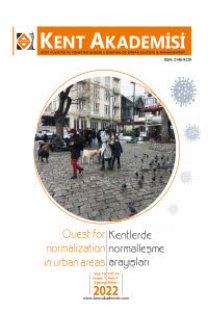İnsan Ölçeğinde Tasarlanan Kentsel Mekanlar ve Kent Sakinlerinin Aidiyet Duyguları Üzerine Bir Değerlendirme
Kentsel tasarım, İnsan ölçeği, Aidiyet duygusu
An Evaluation of Urban Spaces Designed at Human Scale and Urban Residents' Sense of Belonging
Urban design, Human scale, Sense of belonging,
___
- Kitaplar:.................................................................................................................................................................................
- Alexander, C., Ishikawa, S. and Silverstein, M. (1977). A pattern language, towns, buildings, construction. (Second edition). New York: Oxford University Press.
- Arnold, H. (1993). Trees in urban design. New York: Van Nostrand Reinhold.
- Carmona, M. Tiesdell, S. Heath, T. and Oc, T. (2003). Public places- Urban spaces: the dimensions of urban design. Oxford, UK: Architectural Press.
- Ching, F. (2007). Architecture: Form, Space and Order. 3rd ed. John Wiley & Sons.
- Dover, V. and Massengale. J. (2013). Street Design: The secret to great cities and towns. Hoboken: Wiley. Gehl, J. (2010). Cities for people. Island Press.
- Glaser, M. Hoff, M. Karssenberg, H. Laven, J. Teeffelen, J.V. (2012). The City at Eye Level – Lesson from Street Plinths. Eburon Academic Publishers. Delft, the Netherlands.
- Greene, H. (1976). Mind and image: an essay on art and architecture. Lexington: University press of Kentucky. Hajer, M. and Reijndorp, A. (2001). In search of new public domain. NAI Publishers, Rotterdam.
- Hall, E. (1966). The hidden dimension. Garden City, N.Y.: Doubleday.
- Hedman, R. (1984). Fundamentals of urban design. Chicago: American Planning Association.
- Jacobs, J. (1961). The death and life of great American cities. New York: Random House.
- Jacobs, A. B. (1993). Great streets. Cambridge: MIT Press.
- Karssenberg, H. ve Laven, J. (2012). The City at the Eye Level. in Glaser, M. Hoff, M. Karssenberg, H. Laven, J. Teeffelen, J.V. The City at Eye Level – Lesson from Street Plinths. Eburon Academic Publishers. Delft, the Netherlands.
- Kay, J. H. (1997). Asphalt nation: how the automobile took over america, and how we can take it back. Berkeley, CA: University of California Press.
- Lovell, N. (1998). Locality and Belonging. London: Routledge Publishing.
- Low, S. M. (1992). Symbolic ties that bind. In I. Altman, & S. M. Low (Eds.), Place attachment (pp. 165–185). New York: Plenum Press.
- Marcus, C. C., and Francis, C. (1998). People places: design guidlines for urban open space. (Second edition). New York: John Wiley and Sons.
- Salingaros, N. A. (2005). Principles of urban structure. Amsterdam: Techne Press. Steel, F. (1981). The Sense of Place. Boston: CBI Publishing Company.
- Teng, L. (2012). Human scale development. School of Planning and Media Design: Blekinge Tekniska Högskola.
- Makaleler:..............................................................................................................................................
- Antonsich, M. (2010). Searching for belonging—An analytical framework. Geography Compass, 4(6), 644-659.
- Berlyne, D. E. (1971). Novelty, complexity and hedonic value. Attention Perception and Psychophysics, 8(5), 279-286.
- Ewing, R., Handy, S., Brownson, R., Clemente, O. and Winston, E. (2006). Identifying and measuring urban design qualities related to walkability. Journal of Physical Activity and Health, 3(1), 223-240.
- Ewing, R. and Handy, S. (2009). Measuring the unmeasurable: urban design qualities related to walkability. Journal of Urban Design, 14(1), 65-68.
- Gehl, J., Kaefer, L. J., and Reigstad, S. (2006). Close encounters with buildings. Urban Design International, 11(1), 29-47.
- Hansen, G. (2014). Design for Healthy Communities: The Potential of Form-based codes to create Walkable Urban Streets. Journal of Urban Design, 19(2), 151-170.
- Hidalgo, M. C., and Hernandez, B. (2001). Place attachment: Conceptual and empirical questions. Journal of Environmental Psychology. 21: 273-281.
- Long, Y. ve Ye, Y. (2019). Measuring human-scale urban form and its performance. Landsc. Urban Plan. 191, 103612.
- Maslow, A. H, (1943). A Theory of human motivation. Psychological Review, 50, 370-396.
- Osman, D.A.M. (2018). A Place to Meet: The Art of Making the City’s Street. European Journal of Sustainable Development, 7(1), 33-45.
- Scannell, L., and Gifford. R. (2010). Definding place attachment: A tripartite organizing framework. Journal of Environmental Psychology. 30: 1-10.
- Stamps, A. E. (1999). Architectural detail, van der laan septaves and pixel counts. Design Studies, 20(1), 83-97.
- Stedman, R. (2002). Toward a social psychology of place: Predictive behavior from place –based cognitions, attitudes, and identity, Environmental Behavior, 34, 561-581.
- Bildiriler:................................................................................................................................................................................................ Lennard, S.H.C., Ungern-Sternberg, S., Lennard, H.L. (1997). Making Cities Livable, Wege zur Menschlichen Stadt, International Making Cities Livable Conferences, California.
- Radwan, A. H. ve Morsi, A. A. G. (2019). The human scale in public spaces. an analytical study of new cairo settlements. Building The Future “Now”: Rights to Better Living, Architecture and Contexts.
- Web siteleri:................................................................................................................................................................
- Burke, S. (2016). Placemaking and the Human Scale City. Project for Public Spaces. https://www.pps.org/article/placemaking-and-the-human-scale-city. (Erişim: 25.04.2021).
- Raporlar:.........................................................................................................................................................................
- European Green Capital Network [EGCN]. (2020). How Can Your City Get To... A Human Scale?, An Initiative of the European Commission.
- ISSN: 2146-9229
- Yayın Aralığı: Yılda 4 Sayı
- Başlangıç: 2008
- Yayıncı: Karadeniz Yazarlar ve Şairler Derneği
Çankırı Kentsel Sit Alanı'nda Kent İmgelerinin Değerlendirilmesi
Pelin ŞAHİN KÖRMEÇLİ, Gamze SEÇKİN GÜNDOĞAN
Murat ATALAY, Duygu AYDIN ÜNAL, İsmet BALIK, Ahmet FİDAN
Tarihi Alanların Ses Karakterinin Belirlenmesi: İsmailbey Külliyesi, Kastamonu
Çankırı Kentsel Sit Alanı'nda Kent İmgelerinin Değerlendirilmesi
Pelin ŞAHİN KÖRMEÇLİ, Gamze SEÇKİN GÜNDOĞAN
Kent Parklarının Biyofilik Tasarım Kriterlerine Göre Yenilenmesi: İskenderun Millet Parkı Örneği
Yerel Bir Politika Aracı Olarak Paradiplomasi
Esra ÇELEBİ ZENGİN, Ali Davut ALKAN
Üsküdar’ın Kent İmgeleri Bağlamında Okunabilirliği
Ekoköyde Bir Sağlık Yapısı Örneği: Kıbrıs Büyükkonuk Aile Sağlığı Merkezi Projesi
WELL Covid-19 Sertifika Yapısı ve Kriterlerinin Değerlendirilmesi
